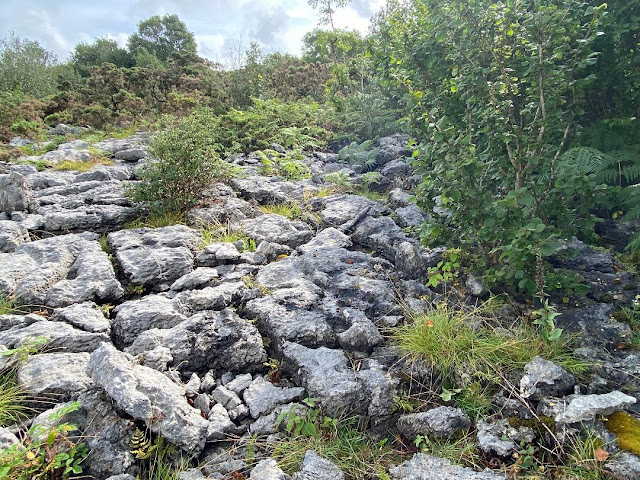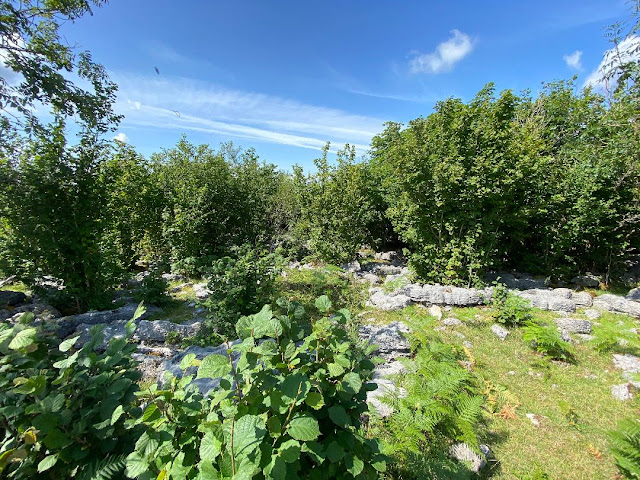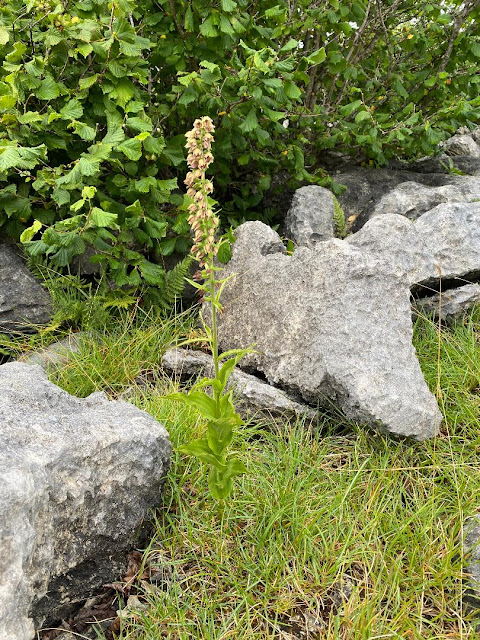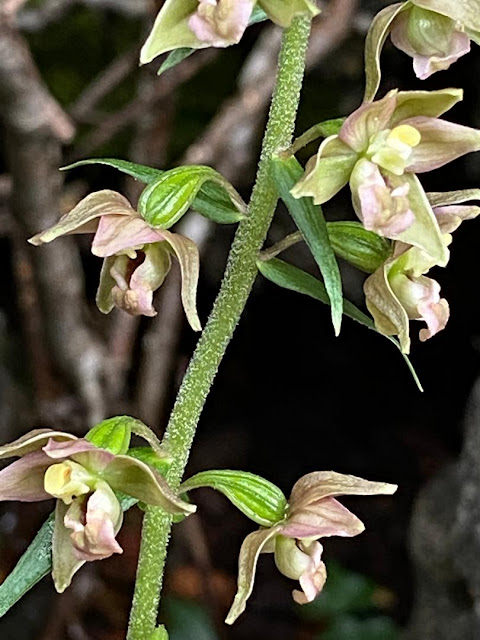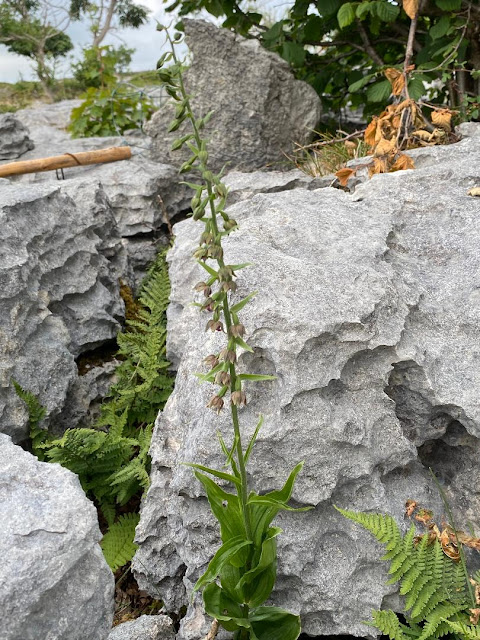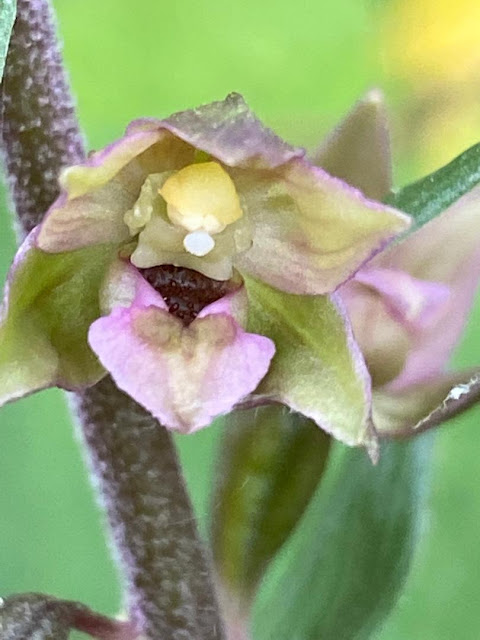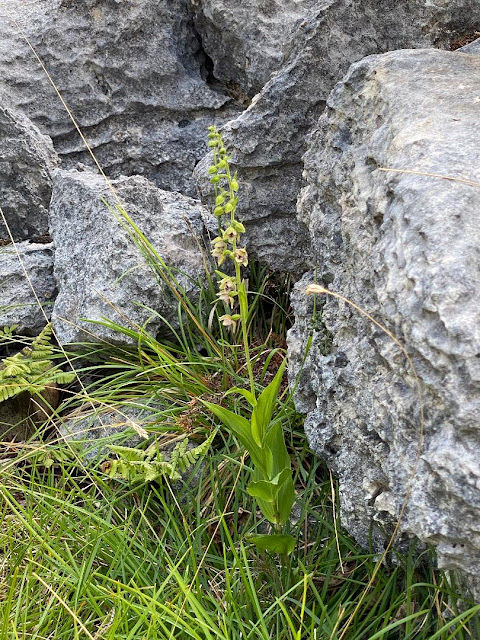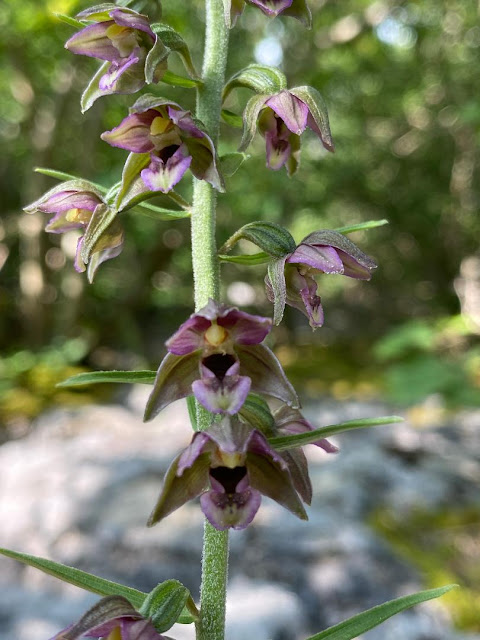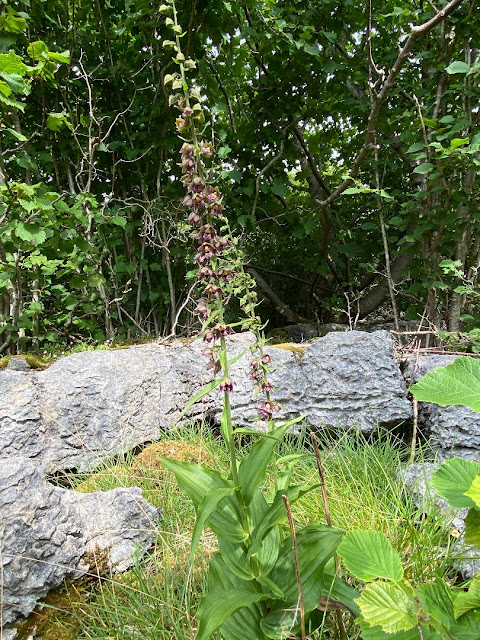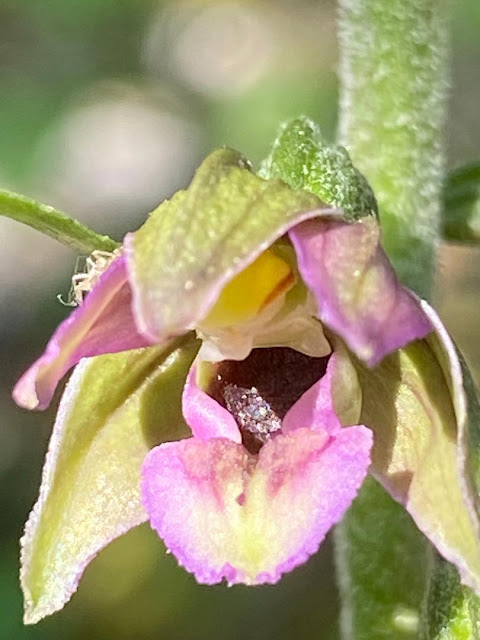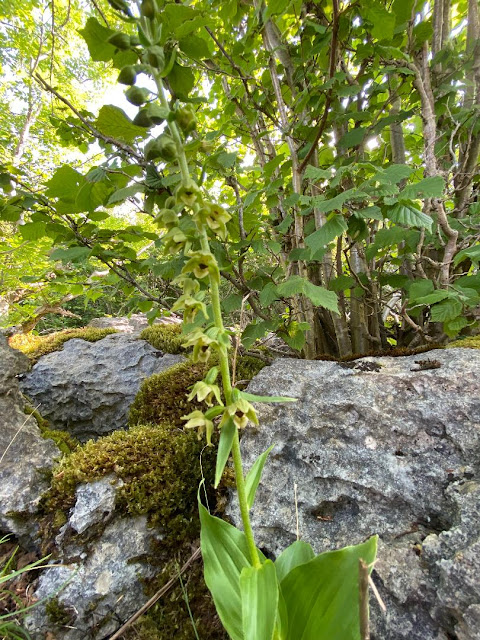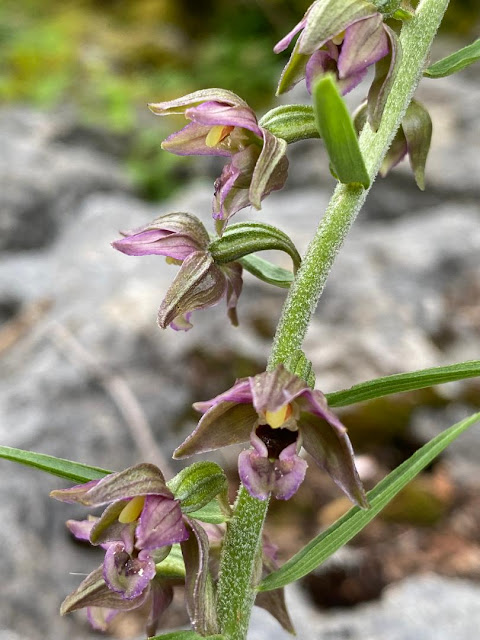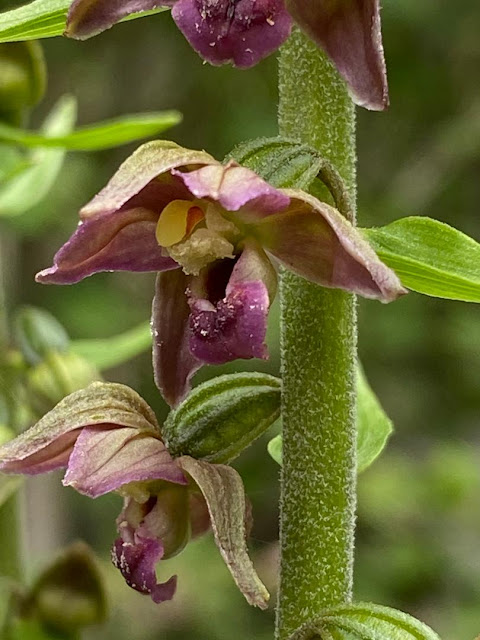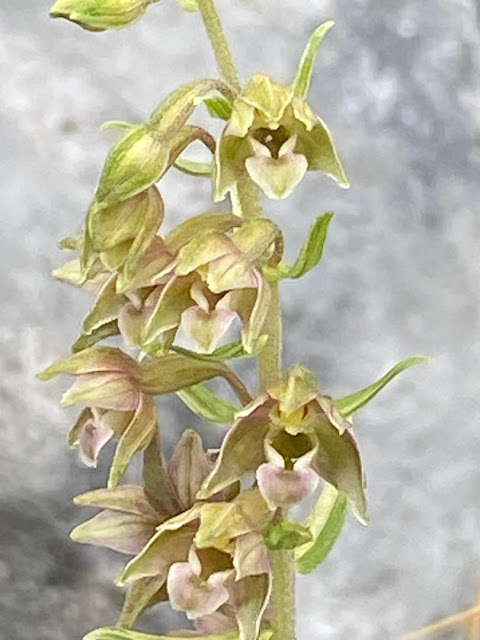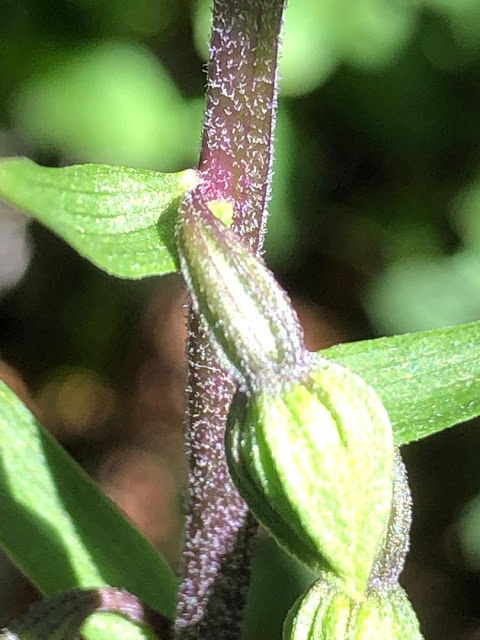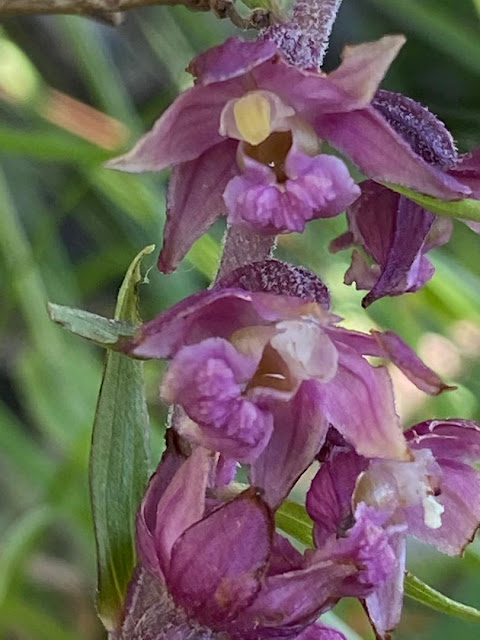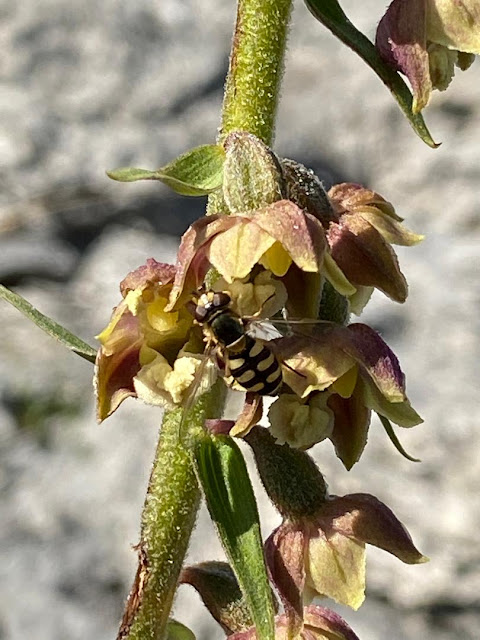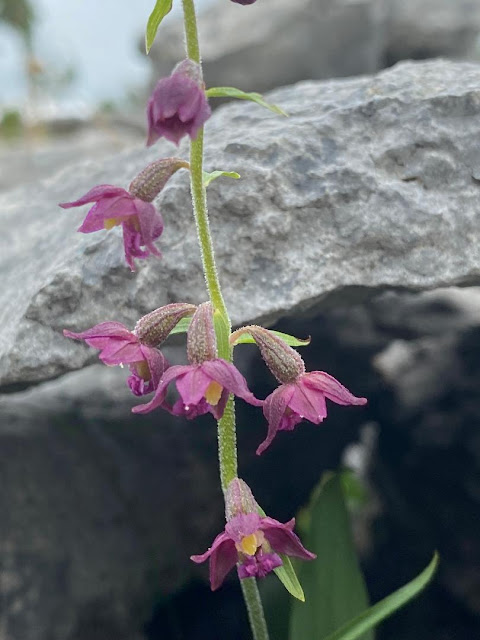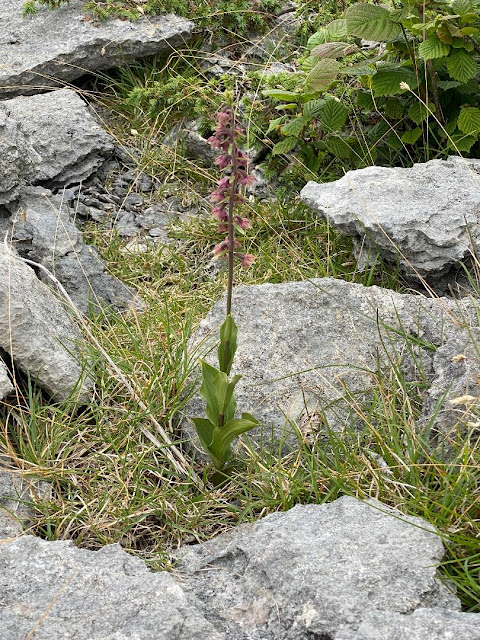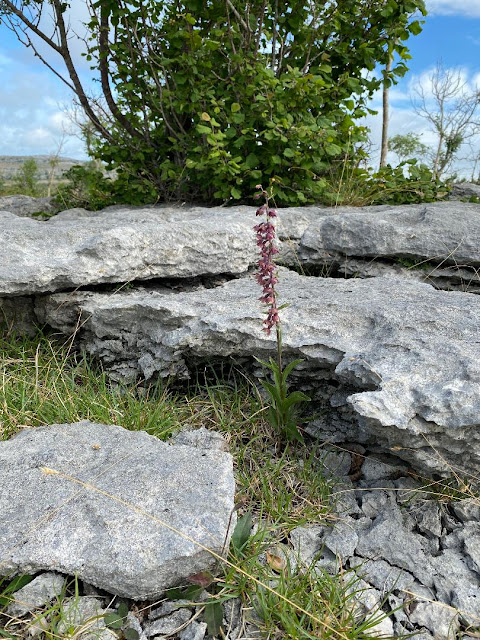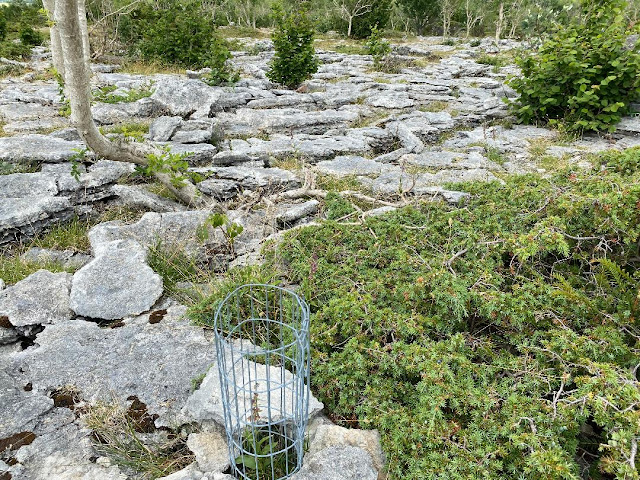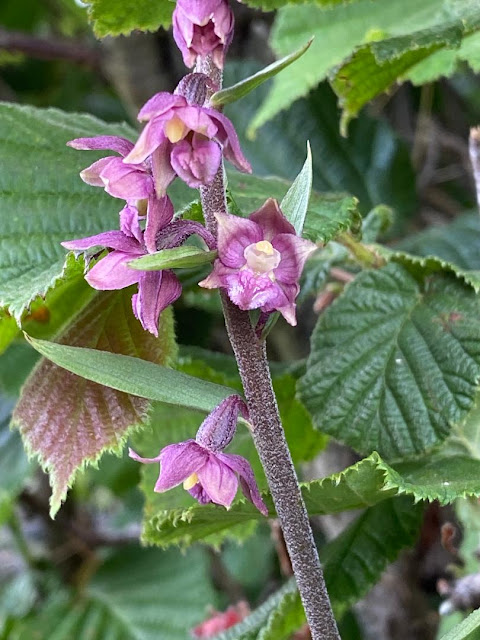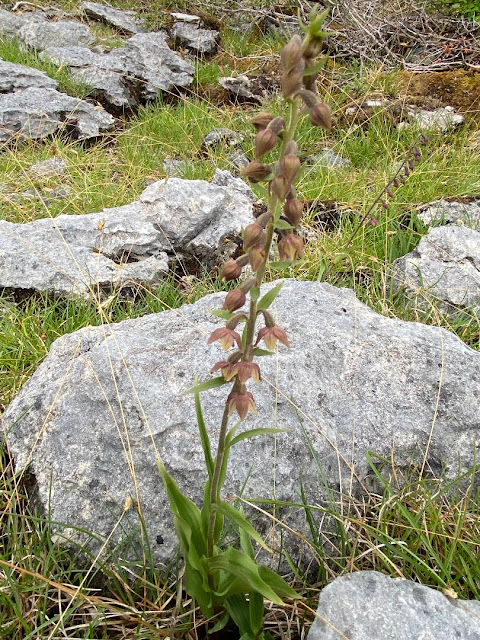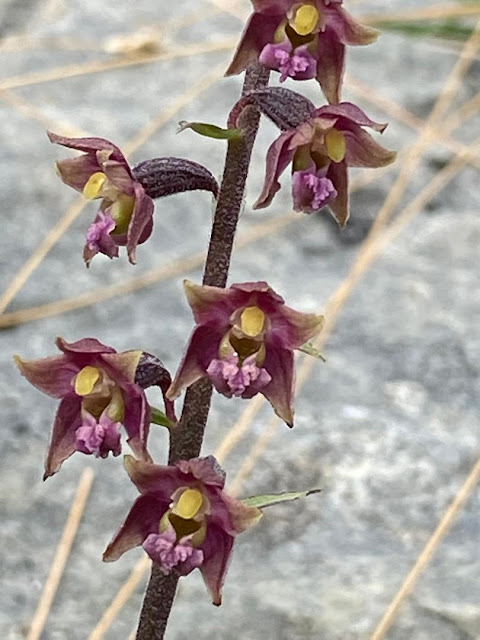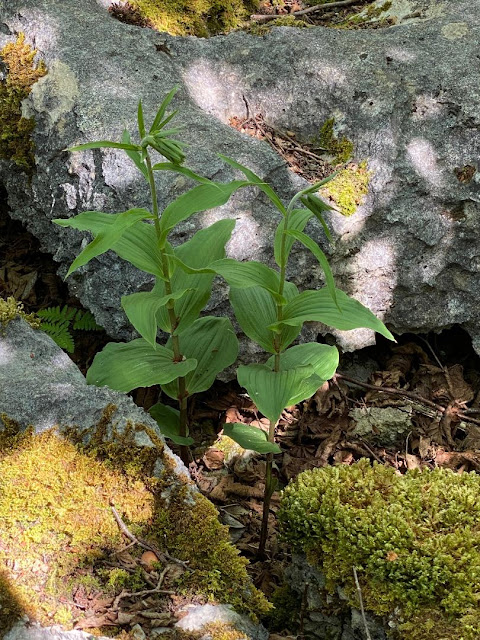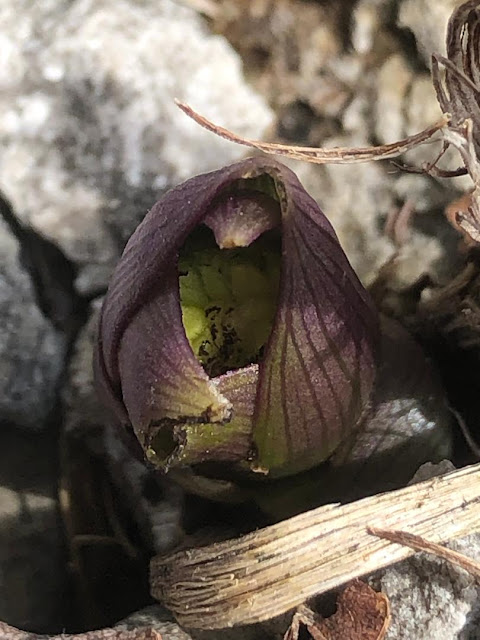final check of ovary and release
Went up
on the Fell today (Burton Fell) to check out how the orchids were doing and
hoping they had fat ovaries etc.
First of all I checked Chlorantha
No.8 and noticed that most of the infloresence was missing with just a couple
of ovaries left (Roe deer). The majority of the helleborines were OK, they may
have been helped with them being in the centre of spread Juniper.
Then went over to see the special
Schmal 100, and straight away noticed it had been stripped of the full
inflorescence (Roe Deer). Last time I
saw the plant it had matured full ovaries, I just hope they managed to burst
and dispersed the seed before the deer took it down. The close area all the
straight atrorubens were still intact.
The horrors started to happen
from the moment I went inside the main helleborine canopies and they had done a
proper clean up job, taking down a good 75% of the E. helleborines in the area
including perhaps 90% of the special specimens which were seen all with their
inflorescence missing, just odd ones had odd ovaries still intact.
All the dark stemmed specimens
had been taken down, in fact the beautiful E. helleborine Dark Stem Spec 10
they had somehow managed to chop down the inflorescence from within its one
metre cage. I had made a strong wire cage and gave it a covering of chicken
wire to ¾ way up, but the deer had nipped it just from were I left off with the
chicken wire. Maybe a lesson that next year I will cover the full one metre
high cage with chicken wire to all areas.
Odd special atrorubens had been
completely nibbled (Roe deer) and it hurt a bit when I noticed Pallens “Insipid”
had been taken down.
Thankfully the Westmorlandii all
seem intact with full ovary – not splitting just yet.
The variegated was all OK and
splitting her ovaries.
Special specimens 40,40a,66,55
and Pallens Rich M, 17d PMG all OK, 15,15a,15d and 33 all OK with split ovaries.
So although we have had major
problem with the E. helleborine it looks like the atrorubens have been OK with
perhaps a 25% loss due mainly to roe deer predation and just odd few this year
put down to Brown Hare.
Finishing of the orchid season
I guess were at the end of another fabulous year of rummaging about in the orchids.
The helleborines have been fantastic, especially the ones under canopy. I know we say the helleborine is so variable and rightly so after the many many differences I have been fortunate to see this year I suppose I could name about twenty variables at least and probably some of those names would make sense, but why on earth would I want to try and complicate things. By the same belief I also feel the heading of "variable" is insufficient!
People have said over the years just what a special place Hutton Roof is! and thats been both orchid lovers and other people with botanical or non botanical interest. And everyear those words prove themselves to be more and more.
Its a special magic which seems to want to suck you into its unravelling secrets, a place were "wonders" are created, and are still being created and will hold their secrets until the end of time, YET it is prepared to open up just that little bit to its faithful scholars. But it is very clever and takes a year to tell you a paragraph or thats how I feel, the need for its knowledge is only to be drip fed. But slowly there will be progress.
Its such a mixed up place like no other, with Helleborines going in every single direction with morphology turning itself inside out and back again. If the truth was really known I am convinced we have more hybrids than could be reckoned, but it really is only the start because pointers along the way have led me to think now that the wonders have moved on and on and on and some of the plants we are looking at are at the many stages of introgression.
Thursday 12th August 2021 - Hutton Roof
Today I went round checking and removing cages to a neutral ground, managed a few photos etc.
15d hybrid
Chlorantha in 2017, as above today
This was a beauty I found today well under canopy and such a lovely light form
Large one metre high specimen e. helleborine, very dark in leaves but all fine and dandy with a 100% helleborine cilia reading, am I surprised!
flowers from above plant
Another victim of Hare - unusual to see well out on the pavement - see previous
Victim of Hare
Rare pallid form "insipid"
Monday 9th August 2021 - Hutton Roof
Just a few photos from todays check overs
Thursday 5th August 2021 - Hutton Roof
Winding down, but back on Fell this morning because I wanted more photos of the "Dark Stemmed" specimens, so I could check more details over the coming days. Here are the photos:
All the (below) photos relate to Specimen SW7
All the below photos relate to Specimen SW9
All the above photos relate to Specimen SW9
All the below photos relate to Specimen SW13
All the above photos relate to Specimen SW13
All the below photos relate to Specimen SW1
(above) Westmorlandii specimen no. 5
Tuesday 3rd August 2021 - Hutton Roof
Not much for me to do now, maybe get one more day later in the week, then another day at the end of next week checking out the ovary situation on both atrorubens and helleborines and I nearly forgot our rare "westmorlandii's" which are already doing fine., then one final day removing the cages to neutral ground and away from the orchids for winter storage.
So today went well just checked on odds I had missed and went back over some of the beauties.
Checked all the dark stemmed and they get more interesting. Its obvious with them you not only get dark stemmed but you also get the leaves and ovaries also darkened. Also interesting today that a couple of the flowers are showing mixed basal collosity which is yet another indication of possible hybrid. But lets face it with Hutton Roof thats actually become the norm. Let me put my old poem here for you to read:-
(Poem I wrote July 2016)
Monday 2nd August 2021 - Hutton Roof
It was time to check out a whole new set of helleborines which lie to the West side of the top. I must have checked over 40 ranging in various sizes. One thing that stood out a mile, every single specimen were loaded with flowers to two sides of the stem only. I cant say I had one plant that had a full circular head of flowers (or bunched).
I also took a leaf sample from the "suspect helleborine" which was close to the westmorlandii. The result bore helleborine to the majority of the leaf, although there was a area which was definately different but certainly not to be related to the regular profile of E.phyllanthes
Here are a few of the specimens:
Saturday 31st July 2021 - Hutton Roof
Just had a brief visit this morning to show Alan G. our splendid helleborines. Here are a few of the general photos I took.
Again it was noted that most of the helleborines are loaded to just two sides of the stems. The one below also shows interesting leaves.
Friday 30th July 2021 - Hutton Roof
Besides the interest shown on the ones below I did manage to get more shots of other interested specimens lying around. It was great to bump into Martin S. who also enjoyed assessing the variant helleborines on offer. This next one was found by Martin and was yet another of the "chlorantha" series which we have which brings the number up to about 6 in this immediate area. There is another one lying immediately to the back of this by about 4ft.
(above) Chlorantha - fresh found 30th July 2021
(below) a lovely trio of helleborine found on the outside at the side of a small hazel copse
(above) Typical helleborine cilia profile
(above is close up of leaf arrangement)
(below) is another gorgeous specimen tucked away at the bottom of the hazel
(below) Now lots of beauties
(above) recognise that leaf - sheathing arrangment!! that in itself is so so special
Friday 30th July 2021 - Hutton Roof
These look very interesting, they include 3 specimens I found on (Pavement attached) in a small radious of some 50 square yards. Please check out the photos as follows:
Spec 50 (low -helleborine pavement)
Spec 51 (low -helleborine pavement)
Spec 52 (low -helleborine pavement)
Specimen 52 is probably the most interesting of the 3 and the actual leaf profile has been noted before on hybrid family Specimen15,15a,15b and 15c and also on smaller hybrid specimens within the 17 family. So the leaf arrangement on this plant could easily be determined to show atroruben profiles, together with the fact that the flowers again are loaded to two sides only which again are guaranteed atrorubens traits. I just have the one photo of the flower which is difficult to work with and just for now I think we maybe safe sticking with helleborine but it certainly could be on the border line here. I am up again this afternoon and if I do get time will try and get more photo profiles.
Wednesday 28th July 2021 - Hutton Roof
My main purpose today was to do some investigations on a helleborine plant (can be seen below) that is growing within 7ft of the Westmorlandii and bears resemblance in base colours shown within it's epichile and also strange that the shape of the epichile in part do bear some similarity.
Of all the plant specimens on Burton Fell, I really can't say I have known any others that have this similarity in profile. Surely it cannot be such a coincidence when the plant is only 7ft away from the Westmorlandii. But if that was the case would it mean that some interaction is taking place? well maybe it is coincidence, but must be noted and taken into consideration on any future debate.
First of all let me show some of todays photos of one of the actual Westmorlandii's Specimen 6
It was also great to meet up with Val and Richard Hodgson
Perhaps some of the past years Westmorlandii have shown the lip colours in a darker prospect, so I now also show you this photo from 2016
In more recent times we are getting quite a lot of the helleborine plants which do show a similar base colours, here are a few examples collected over the last couple of days(27th and 28th July 2021).
So moving on and my last observations are of the plant in question which is thought to be a specimen of (E. helleborine) which lies in distance 7ft away from it's nearest Westmorlandii (spec 6). Here are some photos and perhaps you can note the lip colouring, and to it's strange lip shape. Again I point out that of all the specimens on Burton Fell, I have only found this particular plant to show these lip profiles and for it to be so close to the Westmorlandii spec 6 makes me wonder if there is some sort of interaction taking place.
(above) flowers loaded to two sides of stem. A very mixed up bag with the leaves - flower helleborine
27th July 2021 - Hutton Roof
Found a lot more new helleborines today. I seem to have taken lots of photos and its put me well behind with other research, so I will need to spread them over a couple of days maybe.
Yes these small hazel copses are holding secrets, lots of fine specimens. Some I found with strange leaf profiles and their flowers loaded to two sides of the stem! even more "dark stemmed".
Anyway here are a few photos for starters
Thats all for now but will try and get more on later today.
Monday 26th July 2021 - Hutton Roof
A really busy morning with the Helleborines, somehow missed Pauline and Ian M-G who were coming up to visit us, but also great to meet up with Philip L. The helleborines this year are so special. I took some of the brown stemmed but then headed to pick up on that trio I found on Saturday last and sure enough they were as good as ever, but this time I wanted to see just how the flowers were in callosity and wondering if we had any mixes etc. I took several photos for me to study at home later.
That large Variegated No. 2 has just put flowers out and they are dark and small just like you would see on atroruben, but they are not opening up enough yet to check the lip etc.
Another of the tall dark stemmed is now flowering and putting some terrific flowers.
Found a "chlorantha" white flowered specimen and behind that was a beautiful light coloured with a almost white epichile then a deep purple band across the top incorporating the helleborine bosses.
Then a checkover and water of my special Epipactis westmorlandii's which are doing well.
This beauty above was outside of the copse and just found hiding close to a hazel, I loved how light it was with the purple/brown band it showed at the top of the lip. Quite stunning against a creamy background.
This is one of our "dark stemmed" which are now in flower (Specimen: Dark Stemmed 1). It came through last year as a pair but one of them got prematurely grazed off.
The specimen has strong leaning towards helleborine, though I am still puzzled about the dark stem situation.
These three beauties, lying within canopy are producing some stunning flowers as you can see here:
The plants are certainly a trio and more or less replication between the three, they are in shadowed canopy and very dark especially on the petals, although there is a dark colouration throughout the plant which you see in the sepal versus petal and the ovary and leaves. This variant of E. helleborine is noted on Hutton Roof and easily named as "var: purpurea" .
(above) And again this beauty which was very dark and in partial canopy. The wasp was so greedy and gorging.
and below are other photos from todays outing:
"when outside of both petal and even the sepal are coloured purple" and also lots of purple tones within the undersides including the epichile"
although it is thought that plants need to be under canopy to receive "purpurea" colouring, that is not necessarily so. I also very occasionally do find the odd specimen outside of canopy which also have "purpurea". Although after saying that the majority are within canopy. But I guess it proves the fact that the deep tones are set within the flower from some other reason other than shade, maybe!
Saturday 24th July 2021 - Hutton Roof
Decided to concentrate on the Helleborines today and they are progressing nicely, probably the bulk will be at their very best during the coming week.
I started off at a very special place, in fact the place which has been responsible for coming up with the "Dark Stemmed" of which I found yet another one today.
In fact every single plant looked interesting in various ways and photos have been taken and included below. The main interest came when I started looking at a lovely trio which had a special look in the petals against sepals, I noticed this last year on a couple of plants, it contrast with much beauty, a green against a pink/purple, so you will see I took many photos of the outside and the inside of the flower, and thats when it started to hot up! I just could not believe for one minute what I was witnessing, a brilliant arrangement of colour, but even that aside, certain flowers within the spike were showing very low basal callosity and then there was another which showed a little helleborine and possibly a little atrorubens mixed in. I also found odd flower examples similar on the other two of the trio. Even the flower look on some of these were without doubt to me atroruben look, so again all this dark stuff!
I moved on only a few yards and there again were more of the special flowers on the Helleborine looking plant and the colours were stunning. I am very familiar with the variety "purpurea" and although they would meet the criteria, I felt there was far more on offer here with the complexities of the actual flowers. I will need to study this area even more over the coming week.
Also I checked out some more notable plants we have eg the Epipactis westmorlandii and found 4 plants in bud, watered the beauties and then over the other side to water the Variagated.
Lots of photos to check through, but here are a few to be going on with.
Friday 23rd July 2021 - Hutton Roof
It was nice to meet up with my friend Richard Bate and we checked out some lovely helleborines together with the special variagated specimen. But the star of the morning just had to go to our special "Westmorlandii" which this year I have 4 plants which will hopefully all make it to flowering. Then I have another one which has already been nibbled and also I found yet another new one down in the gryke. Plus I found odd seedlings as well which hopefully may come through in the next year or two. Here are photos from Westmorlandii specimen no.6
This is obviously a descendant from the first Westmorlandii seen in 2014, it is the second flower up from the bottom. Although the photo may look a little like variagation, that is not so, its just how the camera has taken it. Here below are another couple of photos.
Westmorlandii No. 6
And here below are a couple of photos from the strongest looking "Westmorlandii" Specimen No.5 although it is very difficult to photo with its flowers hardly opening
Thursday 22nd July 2021 - Hutton Roof
Today I checked on other outside pavements linking to ours, but the helloborine numbers seemed well down and subsequently I dont need to spend much time on them. I also found an additional "Westmorlandii" bringing this years family so far to 4 plants.
I did a general look over of everything and "watered" the special and needy! and then moved across the fell to Variagated No.1 (or Stripey) which had even more petals out today. Here below are some of todays photos which alone have answered one or two more questions, after the photos I will go into my analysis of this plant.
Below: Variagated No.1
(above) the variagation within this plant is very strong with prominence showing especially in the leaves and bracts. But on closer inspection I also can see lines across both sepal and petal. Also on photo 3 and 4 you can also see striping on the outer hypochile. To a lesser degree this time the striping is seen but far less on the ovary itself.
The morphological analysis of this plant on investigation over at least 6 years research has shown:
The plant by immediate looks and by the timing of its appearance would be documented as E. helleborine BUT, there are some oddities which I never expected on this plant.
Flower and works: The flowers are always loaded to two sides of the stem rather than what you would expect of all around the stem and spiralling. Also the inner hypochile is mid green in colour which you do not expect with helleborine which would normally be dark red.
The plant stem is quite hairy in places and by no means glabrous which again does indicate possible atrorubens.
And finally when I did some cilia work on the leaf edges I found that the profile were more to atroruben than to helleborine.
Although I do think we have mixed morphological within this plant and with the lack of any visual mixed basal callosity on its epichile, at this stage I dont want to come down as definate hybrid. Probably best to continue with the name SPECIMEN Variagated 1.
(below) Now here are a few more photos from today:
Wednesday 21st July 2021 - Hutton Roof
I had a quick look around the helleborines noting in particular the "dark stemmed" and then it was quickly over to check out our very special "Westmorlandii" of which are now coming into flower.
then briefly stopping off at the very dark blue Harebells, its the only place I can find on here were this is happening, the majority elsewhere are just standard. So I wonder whether its the ground minerals which are causing this effect.
Finishing off with the Variagated 1 which now has some of its flowers showing OK. Like past years the flowers are pretty much giving a helleborine look although the inner hyperchile does show green which is strange!
And now below is a selection of other photos today which include some superb helleborines and the odd atrorubens.
****
(below) Now then today 20th July 2021 I have decided to go back on my long term studies of specimen 17q and now I do feel confident in being able to diagnose it has a hybrid (Epipactis schmalhauseneii). Here are the early day photos from the 8th July and right up to the plant starting to turn on the 19th July.
I have thought now for some five years or more that it was a special hybrid, but just wanted to be absolute (or as near to absolute as one can get.
Like I say it's history has always given this one a typical hybrid look, eg: straightaway you note the basal and secondary leaves are more likely to be seen on a helleborine rather than a atroruben flowered and timed plant like this one is, but sure enough you can see helleborine and also note the leaves are also spiralling around the stem which again is another helleborine feature.
a special plant needs added protection
17q on 10th July 2021
the inflorescence seems to tell a story with most of the hybrids, with its compactness all around the stem, with flowers tightly packed together just like this. Its another typical helleborine feature. The ovary is hairy like you might expect with atroruben. A sort of frosty look on a very compact inflorescence.
"The inflorescence of one of our Dark Stemmed Helleborines"
19th July 2021 (0930hrs to 1300hrs) - Hutton Roof
For me its all over now with the atrorubens, although I may still find the odd one tucked away under the shelter of a hazel tree, who knows, but preparations are ongoing in readiness for the research of the "whopping" helleborine beauties we have this year especially, the newly found stuff on the limestone pavements below my regular study area.
What I wanted to mention was how quick things are changing right under our nose! I thought evolutionary process took hundreds of thousands of years, I hadnt banked on changes within twelve months to ten years. Let me try and give a summary to the massive changes I have seen over the past ten years.
First of all we had the atrorubens - bicolors, the red sepal and yellow petal, when I first started recording here I had two specimens on the full pavement, and these numbers have grown year on year and now I can record scores of them (Over 8 years).
Then we have had "light green stemmed" flowers appearing with a swarming taking place by at Population 30 and again and even more prolific at Population 9. I originally found 1 specimen back in 2012, and this one specimen brought so much excitement! and yet now I can find scores, with probably up to at least 50 specimens (Over 8 years).
Then we started getting "dark stemmed" helleborines, with odd ones turning up within population 70 and up to 10 more recently discovered down near population 100. Several more have turned up since last year, as though they are also going to be a annual increase as well!
I started to notice last year 2020 that some of our atrorubens were coming through a beautiful sort of light cherry red which I cant say I'd seen before, and this was only a few (less than 20), but this year we have had hundreds turning this beautiful colour (not complaining) but what can be happening! Also I have noticed that we are getting far more deep purple flowers (sort of hyperchromic) more resemblant perhaps to what you would get on Magnesium rather than Carboniferous and maybe typical to the specimens which are commonplace at Bishop Middleham.
Back to today: I closed my research on Specimen 17q and it does seem to match lots of the requirements you would expect for a hybrid.
I spent most of the morning checking through the large helleborines on the next pavement down, and some are real beauties. Even more of the lovely brown stemmed, I will put some examples of photos soon showing hairiness and deep red colour patches etc, it gets more and more interesting. Its nothing to do with ground minerals, you will get a dark stemmed one growing sided by side of a more regular type.
These photos are from a selection of specimens:
17th July 2021 (1300hrs to 1630hrs) - Hutton Roof
I wanted to spend more time evaluating specimen 17q by taking more photographs etc and check the specimens immediately in the vicinity. Lots of photos can be seen below. Also I checked out 15d (or PMG) which has come more into flower today, then off to check out more specials before eventually arriving over at the Specimen variagated No.1. I later wanted to check out the ovaries especially on the 15s family. They are swelling niceley. Whilst there I found a beauty tucked away and half hidden by the Juniper but was about 3 metre to the N of 15d, this specimen is now called 15g.
Here below are some of the photos from today:
16th July 2021 (0900hrs to 1130hrs) - Hutton Roof
It was a flying visit to the roof this morning, needed to be over on the Stints for 1130hrs - Butterfly meeting (High Browns), so wanted to check out the fantastic aptly named Specimen 100 to make sure it was the one I found last year and sure enough I compared the photos below and thats the one....
Just like the old days finding this Hi-vigour Specimen, you dont find these so often in fact your lucky if you find one over a five year period, so you can see why it is of so much importance to me. All photos taken on Iphone 8 or 11.
Here (below) in these two photos you see a close up of the plant (Specimen 100).
This below is from the 17s family, the area itself leads to lots of suspicious plants mainly because of their leaves which on the majority of plants look similar to what you see on Broadleaved rather than atrorubens, you can see this in the bottom photo. Another trait of this particular area is the large amount of very deep magenta coloured plants we have in this area, although after saying that we still do have some fantastic bi-colours. It's an area I have always considered lots going on.
15th July 2021 (0930 to 1200hrs) Hutton Roof
Yesterday whilst up on the fell I had the pleasure in meeting up with friend David Nattress who kindly put me on to a absolute stonker! from his explanation I remembered it from last year although all I got chance to see last year was a beautiful specimen with very hi-vigour stem (without inflorescence, which had already been raided) and extroadinary leaves, but I guessed just how it might well have look and sure enough it turned up trumps today. Thanks to Dave telling me of this he had only found that very specimen yesterday and from how he described it I guessed he had found the special one. - just look at this special Specimen named 100 coming off the more westerley fragmented pavements.
This is how I remember it last year 2020. The plant looks identical although the angle maybe different. I feel reasonably confident this could well be the same one.
Variagated No. 2
Dark and beautiful
than its regular which can be seen to its left.
Burton South West pavements looking North West.
ABOVE: Specimen 17Q inflorescence
I feel like I can see both helleborine and atrorubens in the flower itself. Especially at the flower directly centre and some of the others as well. You note the smooth clear double boss which is the input from helleborine yet on some others it does have the frilly boss which obviously is the input from atrorubens. I will try and get some clearer photos over the coming days.
fantastic and true colour 17a
follow on from Hybrid 8 which last flowered a few years ago from then asingle to now a duo
14th July 2021 (0930 to 1300hrs) - Hutton Roof
Today was a quieter day helping friend Alan G to find certain specimens which he could use within a video, we checked over some of the old specimens together with some new ones found yesterday.
I checked out the 55s and obviously it is becoming clearer that the atrorubens are now past their best and on the way out, yet there are still odd ones that are OK and probably I will carry on finding them until maybe weekend.
From then on I guess I will be devoting most of my time to the fabulous helleborines which are currently lying in wait to flower.
It was great to get photos of the very "insipid" Pallens 11 which you can see below.
Also today I have posted a photo of 9 (f2) shown against what I consider could be the parents in the hybrid photo.
Dark Green Fritillary butterfly
Heavy laden with Juniper fruit
A lovely atrorubens showing that special red which seems to be coming through this year with lots of specimens photographed showing this NEW shade of red.
This is the famous Pallens which is called RICH M, the name of the finder
Alan G.
This is Escarp 8 or Pallens 3 and obviously going over quickly, but I wanted to show this in particular to the swelling of the ovaries which does not take long.
I do have some interesting stuff about these Pallens eg: this one and also Pallens 4 and 4a and 5 and 5a and that is they have produced offspring within one metre of the main plant. I find that very interesting especially with them all being Pallens and come through similar but certainly not a replica of the main plant. It does make me think why would the offspring come through Pallens without reverting back to normal regular atrorubens. For me it probably proves the fact that Pallens is here to stay it is not a one off, it means to go on and on and develop in its own right.
Now then this for me has gone up in the World this year and this is how it looked today, although I did have my suspicions about this plant a few years ago. It's our beautiful "variagated" and mentioned in Jon Dunns book "Orchid Summer" with the name of STRIPEY. Its looks like a Broad Leaved Helleborine, but I am not sure about that! Next are a couple of photos back from about 2017 when it shows it in flower last.
This is a photo from about 4 years ago and gives you a indication of the look in the petals and sepals of atrorubens, together with loading flowers to two sides of the stem.
And finally I did some checking of the denticulation of one of the leaves and guess what? It shows a good line of atroruben profile.
I am now quite happy that this plant should be described best as a hybrid.
***********
(below) now back to todays photos
you note in 17s that the leaves look very helleborine
This is specimen 11 which I have history since 2014, we feel confident in calling it a hybrid (schmalhauseneii) it is one of a linked pair which has been browsed off. It's looking the best it has shown for the past 5 years.
just a very nice atrorubens
Its interesting that back in 2012 I had two pair of hybrids almost 2 metre apart, one pair were called 11 and 11a and the other two were called 9 and 10. Now then 9 and ten were very full on hi-vigour plants and had a unique colouring like nothing else ever seen on Hutton Roof, but the hybrids died back a couple of years later (2014) now last year I had a miniature version of that same plant (hybrid) which has come through again this year, so obviously this confirms for me we have gone into introgression with these plants. I will post you now a photo of that 9 and 10, and then I will post you beneath it the new 9 (rep: introgression)
9 and 10 back in 2014 and gone down by 2015 by hare grazing and never came through since 2016 but almost to the same spot I have had weakened versions which I think could well be introgression (F2) and here are the photos
This plant which is probably best to be called No.9 (F2) for now shows lots of similar characteristics especially in the colour which like I say is not found elsewhere on this pavement. But it is of a far weaker build and like most previous suspected F2 I have found nearly always come through frail and deformed just like this one appears to be. In my mind I have no doubts that you are seeing the hybrid (schmalhauseneii) in the previous photo and you are seeing the introgression (f2) within the photo above.
Now then I do promise not to get sidetracked again and will offer the following LIGHT green stemmed plants I have had amongst the 30 today which are without doubt swarming in a area of only 30ft diameter which could also be prime candidates again for introgression (f2,3,4,5, and on). Most of these are now into their 2nd or 3rd year and getting stronger.
13th July 2021 (1000hrs to 1600hrs)
Today it was the turn of "The Flora of Cumbria Group", a large party came to check over the Epipactis and later in the day we checked out the Hypericum montanum.
It was very good and the party found one or two new light specimens of atrorubens which I will try and valuate over the next few days whilst visiting the pavements again.
Also it gave me chance to go over into Lancelot and we checked on Schmal 1 (hybrid) which has come through fine and dandy (see photo below).
The party really enjoyed seeing the "new" dark stemmed helleborines we are finding on both Burton and Lancelot.
Here are just one or two photos from todays great outing with some great friends old and new.
Gosh! seeing these beauties on yet another pavement was so interesting, not only are the stems dark but the leaves are also turning darker as well. I know this area very well and some of the plants have history of "purpurea" but these three are just so special......
12th July 2021 (1300hrs to 1600hrs
On off drizzle throughout but no problem, checked out some new beauties in 55s population, then over to 40s, collecting cages to put around the special variagated. Then straight over to 9s photo some Pallens or light green stems etc. Here are a selection of photos taken on Iphones 8 and 11.
10th July 2021 - Hutton Roof (1000hrs to 1500hrs
Also nice again to meet up with Terry Swainbank who had come up on his own and we held some really good discussion about the many "light green" plants we are getting in certain parts of Hutton Roof which are obviously "swarming". It was suggested that these were the follow on from past hybrids and would come under the banner of "introgression rather than hybrid".
Our party also enjoyed checking out the new 100 plus helleborine find on the next pavement down.
This particular variagated which is nicknamed as "stripey" was well liked.
9th July 2021 - Hutton Roof (3pm to 8pm)
Nice meeting up with orchid friends Dave and his sister from Kent and always nice to meet up with my dear friend Dr. Hawkeye who actually lives quite local nowadays.....
I roughly went over the 55 areas and then over to the 9s etc.
Getting very difficult now for photos, aching heavy with all the contortions etc etc over the past few days to get these photos. Anyway did manage a few photos here: (all photos on Iphone 8 or 11) I wont be doing photos today (10th July), having a day off from photos because it's the Hardy Orchid Society party and I will be kept busy with that. I will try and tag some of these when I get back.
8th July 2021 - Hutton Roof
Was up there between around 0900hrs and 1400hrs, in and out of brightness and little wind.
I covered the NW side today again and it was fabulous with lots of new atrorubens all over the place, probably the best year I can remember in the past 12 years. Also some are achieving good size.
The majority of the best orchids are at their best right now and will be for the next few days, yet there are still lots waiting to come yet.
To be honest there was so much good stuff everywhere you looked and so I took lots of photos, in fact it was like I can imagine when a child enters a toffee shop!
So I started off today checking our 33 a bicolor with a light epichile and boss, then went over to 55 and again checked out the special bicolor on green stem, and also found more in the 55s and certainly worth a photo or two, then over and checked the 40s duo, first time flowered now for the past 5 years, surprising what a good cage can do. Then checked out the 15d hybrid and the new one next to it, then on to the hybrids 15a and 15b, doing nicely - again cage holding well, then over to the Escarpment and checked on the best bicolor Esc 13, then checked the pallens and all petals opened now. Also took many more around the escarp areas: All photos took on Iphones 8 or 11.
7th July 2021 - Hutton Roof
Went up this morning checking one or two things and moving about cages etc. All looks really good more and more nice atrorubens are coming into flower.
I spent time at 33 which is a dull coloured bicolor but always with amazing epichile and bosses, and got some nice shots also of 66 bicolor. Also went over to Escarp 8 (pallens). Overhall the Pallens are having a terrible year with only 3 (eg: Escarp 8, Rich M and 9) showing up at the moment out of 10, but its still early days.
Here below are some of todays rewards. All photos today by Iphone 11.
The above is Specimen 66 bicolor var
The above is Specimen 66 bicolor var
The above is Specimen 66 bicolor var
The above is Specimen 66 bicolor var
always a beauty, always special with light coloured epichile and boss. Long established.
Specimen 33 var: bicolor
always a beauty, always special with light coloured epichile and boss. Long established.
always a beauty, always special with light coloured epichile and boss. Long established.
6th July 2021 - Hutton Roof
Today was good after the rains, a little bright and gusty winds at time and difficult to photograph, but still managed a few.
I did concentrate quite a bit on another special bi-colour which we have which comes from the 17s family. Usually by now it has had its inflorescence removed, but so far so good. Also managed to cage a pair of light coloured green stemmed in the 17s area. Checked out more on the non regular spots and there are some very tall specimens coming through this year. All photos today by Iphone 8 and Iphone 11
Special Bicolor in the 17s population
Special Bicolor in the 17s population
Special Bicolor in the 17s population
Special Bicolor in the 17s population
Special Bicolor in the 17s population
5th July 2021 - Hutton Roof
Today had a sickener on my visit when I found the newly discovered specimen 42 beautiful light coloured had been taken down by deer, I had spent time making a special cage for it as well! never mind there is always next year, but I will make sure it gets caged earlier.....
This is the beautiful 15d which is a hybrid (schmalhauseneii) and the last time it flowered 3 years ago the inflorescence had 62 flowers, this time we have 30 plus.
This is the beautiful 15d which is a hybrid (schmalhauseneii) and the last time it flowered 3 years ago the inflorescence had 62 flowers, this time we have 30 plus.
This one is escarp 13 and is one of my favourite bi-color variety. It always comes through and a fine specimen heading in some years to almost one metre. Here below are one or two more photos from today.
This one is escarp 13 and is one of my favourite bi-color variety. It always comes through and a fine specimen heading in some years to almost one metre. Here below are one or two more photos from today.
The above 3 photos are Pallens 3 or Escarp specimen 8 which has been with us since 2018 and its also last year had a offspring, which has shown itself this year, but not sure whether or not it will make it. Note with this specimen it always shows the little red dots or smudges showing us that it does still belong to the atroruben family!
3rd July 2021 - Hutton Roof
Went up for the afternoon after the heavy rains in the morning, it was fabulous and a totally fresher area, but overwhelmed with the amount of plants which had come into flower within the last 24 hours. Had to take lots of photos, most of them are different plants, but all had brilliant happy faces again.
Here goes, I may add some tags tomorrow if I get chance.- please enjoy.
2nd July 2021 - Hutton Roof
Lovely meeting up with orchid friends from down South and we checked out some of todays beauties, lots more have come out now and the place is getting back to looking more like itself. I only had a brief spell before having to dash off but managed to see lots of little green beauties in the 9 and 11 areas.
Looking down on specimen 72
I checked around the 9 family and as usual there are lots of very light green specimens taking over, here is a small selection below:
Also another little beauty for today
1st July 2021 - Hutton Roof
Today was better with far more plants in flower. I think by Monday or Tuesday things will be a lot different. I have lots of photos from today which are shown below. Also please check the E. helleborine photos as well.
Here are the photos, little time at present so sorry I cannot tag all the photos, but I will try and tag some of them later or maybe tomorrow.
Photo: Hutton Roof - 1st July 2021
Photo: Hutton Roof - 1st July 2021
Photo: Hutton Roof - 1st July 2021
Photo: Hutton Roof - 1st July 2021
Photo: Hutton Roof - 1st July 2021
Photo: Hutton Roof - 1st July 2021
Photo: Hutton Roof - 1st July 2021
Photo: Hutton Roof - 1st July 2021
Photo: Hutton Roof - 1st July 2021
Photo: Hutton Roof - 1st July 2021
Photo: Hutton Roof - 1st July 2021
Photo: Hutton Roof - 1st July 2021
Photo: Hutton Roof - 1st July 2021
Photo: Hutton Roof - 1st July 2021
Photo: Hutton Roof - 1st July 2021
Photo: Hutton Roof - 1st July 2021
(below) are some fabulous photos of something really special in my opinion and it would be very silly for me to call THE plants Epipactis helleborine.......
30th June 2021 - Hutton Roof
Had a good check today and we are struggling at the moment, perhaps half a dozen with flowers, none with full inflorescence, but did manage to collect the odd photo for this diary.
We are in a sad state at the moment because everything up there is parched, you see it, you tred it and some of the little beauties are holding their heads lower than usual! I felt some of the buds which in some specimens have tightened through obvious dehydration. I really do hope its not going to be another year like 2019 when we lost so many! so its chin up and pray for rain.
After saying all that the E. helleborines could not look better if they tried, but thats the secret I guess they are all geared up for a couple of weeks later than the atrorubens.
Our mega rare Epipactis "Westmorlandii" is not on show just yet, in fact not sure he will be with us this year, although I will keep checking on a every other day practice. He would normally try and make an appearance around the first week of July and it would never surprise me if he was not in the line up when the time comes. (For anyone who wonders who is Westmorlandii - then click this link to see the dedicated pages afforded to this very strange plant:
So just to give you an idea of how things are at present there is some cheer when you look at these beauties, all smiling today:
The above and uncaged (briefly) is hybrid schmalhauseneii No. 15d which thankfully this year has come through thanks to caging, although I did note 15c (its parentage) has gone down and not sure how it certainly was not deer or hare, I do suspect vole or mouse on that one! but getting back to 15d (the photos above) its doing well but only about 30 plus flowers this year, and nothing like the 62 it produced back in 2018.
The above plant is not a regular or maybe gone unnoticed but it is quite obviously from the 70s family and lives approx 2ft away from the parent 70 which I have always considered to be a hybrid, and maybe this could be to! I also love the added features of multi-stained stems! This very beautiful deep colouring (in the flower) is typical of all plants found in this sector. I like to think that I can tell most of my plants from their smiling faces, but it's not quite so simple as that, most of them do have their special features or fingerprint, the immediate giveaway with this plant is purely through its colour and colours which that alone nails it down to two areas, then your ready for some other box to tick....
above is 40 and 40a bi-colours which look forlorn at the moment. This is one of the plants I used for the information on the bi-colour, a very special specimen, which sadly is prone to go into a die-back state in such weather. Our atrorubens seem to accept a lot and perhaps go into a sort of dorment stage during shortages of water, but they can only take on so much before the inevitable. I will be given these a little drink very soon!.
(above) are photos showing 40b a small plant and been present to my knowledge since 2014, It's normally the very first plant to flower in any year, but not this year! It lies within 2ft of 40 and 40a although I cannot find any family link as yet, but always puts on such a splendid spectacle, yes one of my favourites and note the bicolor and special "light" epichile and bosses.
Now then I am getting short of time so for now I will just continue with photos alone, please enjoy.
28th June 2021 - Hutton Roof
Taking a small a party from Arnside Nat, a tour of my study area explaining the varieties hybrids and other info, struggled to find any flowering specimens, but just the odd one or two. However the E.helleborines are doing super douper!
26th June 2021 - Hutton Roof
I have been up again today and everything is so far behind I really am struggling to see us getting good numbers of flowering atrorubens before about Wednesday of next week. The problem has been a shortage of water along the way and you can see were all are recovering and doing well now. Anyway after saying that here are one or two from today:
23rd June 2021 - Hutton Roof
21st June 2021 - Hutton Roof
(Midsummers Day)
Today started off well with managing to get a photo showing a Argogorytes mystaceus (wasp) clinging hard to a Fly Orchid.
Moving on I found the first of the year atrorubens plant with a couple of flowers open.
Again some fabulous helleborines on their way.
19th June 2021 - Hutton Roof
Did a quick check out over the past couple of days and everything seems to be doing well with just the odd casualty being recorded on account of deer or hare predation. I guess we are probably 5 - 7 days behind the usual.
Today I did a brief tour of the South side of the Orchid field and it looks like the 11s are doing OK and showing the usual compound growth typical of what to expect with this particular hybrid orchid. Perhaps will grow to one metre. In the same vicinity one of the hybrids as re-appeared after missing for one year. Also a new little pallens beauty is taking shape (see photo below).
The most striking adventure of today was checking out the recently found "Helleborine" quarters on the adjoining pavements. It was incredible in numbers perhaps yielding over 150 sturdy plants (could be more which I will try and survey over the coming week or two) of which we will get several really special specimens. Here below are some of the photos from todays check out:
(above) This one I found last year and instantly recognised it has my idea of a typical hybrid although it was missing its inflorescence by the time I found it (2020), but hopefully this time it will come through OK, looking just the ticket! so far and definately meeting the criteria. And deserved of special protection.
(above) Shame about this one, it was probably one of our better helleborines with a stem diameter of approx 1/2" it was some mean machine, but sadly the deer have already been "naughty".
(below) And now then I want to show you a very special specimen/s SW4/5/6 last year, but this year it is SW 4 and SW 5 with one of them having gone missing... (several photos)
15th June 2021 - Hutton Roof
Today made a new cage for 15d and went up to fix it which all went well. Also spent time changing around and refixing some of the cages for added protection to the vunerable
14th June 2021 Hutton Roof.
Everything is coming along nicely and almost everything present and correct. Here are a few photos to show the progress of some of the "stars".
14th June 2021
(above) Escarp 13 - Bicolor
10th July 2017
photo taken 14th June 2021
24th May 2021 Hutton Roof.
Did a full check up today, the only atroruben type plants showing were plants of high vigour and which included one or two hybrids or very strong atrorubens. Strangely the helleborines were lagging (in my opinion) and these are as a rule the very first to show in regards to emergence shoots.

























